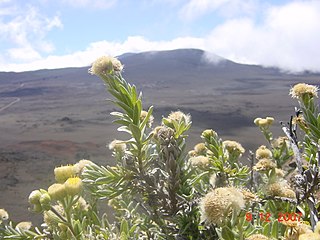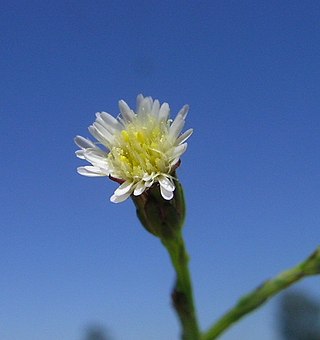
Verbena, also known as vervain or verveine, is a genus in the family Verbenaceae. It contains about 150 species of annual and perennial herbaceous or semi-woody flowering plants. The majority of the species are native to the Americas and Asia; however, Verbena officinalis, the common vervain or common verbena, is the type species and native to Europe.

Symphyotrichum is a genus of over 100 species and naturally occurring hybrids of herbaceous annual and perennial plants in the composite family, Asteraceae, most which were formerly treated within the genus Aster. The majority are endemic to North America, but several also occur in the West Indies, Central and South America, as well as one species in eastern Eurasia. Several species have been introduced to Europe as garden specimens, most notably New England aster and New York aster.

Colubrina is a genus of about 30 species of flowering plants in the family Rhamnaceae, native to warm temperate to tropical regions of Africa, the Americas, southern Asia, northern Australia, and the Indian Ocean islands.

Astereae is a tribe of plants in the family Asteraceae that includes annuals, biennials, perennials, subshrubs, shrubs, and trees. They are found primarily in temperate regions of the world. Plants within the tribe are present nearly worldwide divided into over 250 genera and more than 3,100 species, making it the second-largest tribe in the family behind Senecioneae.

Ericameria nauseosa, commonly known as chamisa, rubber rabbitbrush, and gray rabbitbrush, is a shrub in the sunflower family (Aster) found in the arid regions of western North America.

Pluchea is a genus of flowering plants in the tribe Inuleae within the family Asteraceae. Members of this genus might be known as camphorweeds, plucheas, or less uniquely fleabanes. Some, such as P. carolinensis and P. odorata, are called sourbushes. There are plants of many forms, from annual and perennial herbs to shrubs and trees, and there is variation in the morphology of leaves, flowers, and fruits.

Psiadia, commonly known as daisy trees, is a genus of mostly woody Asian and African plants in the tribe Astereae within the family Asteraceae. The genus is distributed throughout the Western Indian Ocean, with species reported from continental Eastern Africa, Madagascar, Mauritius, La Reunion, Rodrigues, the Comoro islands, as well as several of the smaller, uninhabited islands in the Mozambique Channel. Additional species are suspected on Socotra and Sri Lanka, but these have not been confirmed. Phylogenetic studies using DNA sequence data and biogeographic reconstruction using molecular dating have shown that the genus originated on the African mainland, and colonized Madagascar and the outlying islands in the Indian Ocean in several independent instances of overwater dispersal in the Miocene.

Laennecia or Laënnecia is a genus of flowering plants in the family Asteraceae. The plants are native to Mesoamerica, South America, and the southwestern United States. Common name is "horseweed."
Xylothamia, the desert goldenrods, is a formerly accepted genus of flowering plants in the family Asteraceae. Until 2003, it was held to contain nine species of shrubs native to the deserts of Mexico and the southwestern United States. As of May 2024, Plants of the World Online divided the nine former species of Xylothamia among Aquilula, Gundlachia, and Medranoa.
Jalantzia is a genus of flowering plants in the aster tribe Astereae within the sunflower family Asteraceae. It was previously known as VernoniopsisHumbert, an illegitimate name. Its species are native to Madagascar.
Rochonia is a genus of Madagascarian plants in the tribe Astereae within the family Asteraceae.

Chrysogonum is a genus of flowering plants in the family Asteraceae. As of May 2024, two circumscriptions of the genus were in use. In the broader circumscription, the genus has a discontinuous distribution, with species native to eastern North America and Madagascar. In the narrower circumscription, the genus contains only species native to eastern North America.
Guy L. Nesom is an American writer and botanist.

Symphyotrichum dumosum is a species of flowering plant of the family Asteraceae commonly known as rice button aster and bushy aster. It is native to much of eastern and central North America, as well as Haiti and Dominican Republic. It is a perennial, herbaceous plant that may reach a height of 1 meter.
Psiadia humilis is a species of flowering plant in the family Asteraceae. It is native to Madagascar. It was first described by Jean-Henri Humbert in 1923 as Psiadiella humilis, as the only species in the genus Psiadiella.

Symphyotrichum subulatum, commonly known as eastern annual saltmarsh aster or, in Britain and Ireland where it is naturalized, annual saltmarsh aster, is an annual plant in the family Asteraceae native to the eastern United States and the Gulf Coast to Texas. The species grows primarily in coastal salt marshes, although in the Ozarks it occurs as a non-marine weedy variety.

Erythranthe, the monkey-flowers and musk-flowers, is a diverse plant genus with more than 120 members in the family Phrymaceae. Erythranthe was originally described as a separate genus, then generally regarded as a section within the genus Mimulus, and recently returned to generic rank. Mimulus sect. Diplacus was segregated from Mimulus as a separate genus at the same time. Mimulus remains as a small genus of eastern North America and the Southern Hemisphere. Molecular data show Erythranthe and Diplacus to be distinct evolutionary lines that are distinct from Mimulus as strictly defined, although this nomenclature is controversial.

Symphyotrichum patagonicum is a species of flowering plant in the family Asteraceae endemic to the Argentinian provinces of Chubut, Mendoza, Neuquén, and Santa Cruz. It is an annual, herbaceous plant that grows 3 to 30 centimeters tall. Its flowers have short white ray florets in 3 or 4 series and numerous disk florets.













